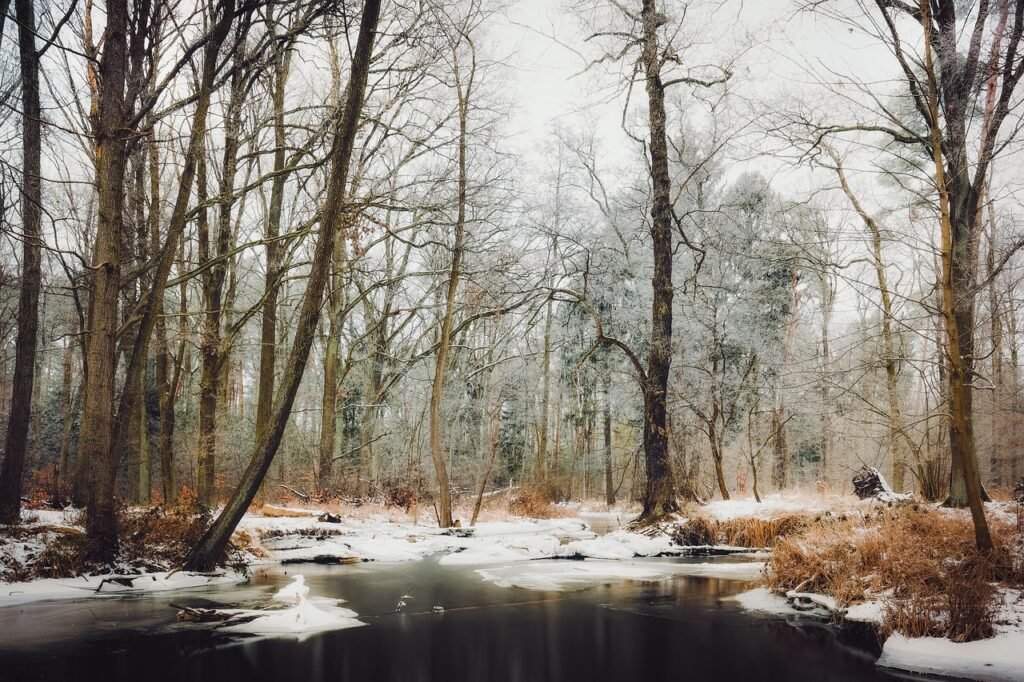What if the things that make you uncomfortable could actually teach you something profound?
The Beauty of Discomfort
Discomfort is often seen as something to avoid at all costs. You might think of it as an unwelcome guest that knocks at your door, and yet, it never leaves when you ask it to. Instead of running from it, what if you leaned into it? The lessons that discomfort provides can be incredibly powerful.
You probably don’t relish the thought of being cold. Cold weather can be harsh, unforgiving, and downright painful. But it also presents unique opportunities for personal growth, resilience, and understanding. In wrapping ourselves in layers of warmth, we often forget the lessons that naturally come from the experience of chill.
Why Cold?
When you think of cold, what comes to mind? Do you picture frigid temperatures, frostbite, and snow shoveling? Or do you envision awe-inspiring winterscapes, cozy nights by the fire, and hot chocolate? The truth is, cold can be both harsh and beautiful. It teaches you about endurance, but also about beauty. Let’s break down some of the lessons you can learn from the cold.
Lessons in Resilience
One of the most significant lessons you can learn from experiencing the cold is resilience. When temperatures drop, so does our comfort. This is where you can truly test your limits. You’ve likely been outdoors during a particularly chilly day, and while you might want to retreat to the comfort of your warm home, pushing through often yields an unexpected reward.
You learn to prepare yourself mentally and physically, to bundle up and brave the elements. This exertion builds character, as you realize that your body and mind can withstand more than you initially thought. Each time you venture into the cold, you gain confidence that carries over into other areas of your life. If you can handle the bite of winter, what else can you conquer?
Mindfulness in the Moment
Being in the cold nudges you toward mindfulness. When the sharp air hits your face, your senses come alive. You become acutely aware of your surroundings, realizing how every small detail—the crunch of snow underfoot, the sound of branches swaying in the wind—plays a role in the experience.
In our daily lives, it’s easy to get caught up in the rush and noise. You may find yourself going through the motions without truly experiencing life. The cold forces you to slow down and pay attention. Suddenly, the bitter chill is no longer just something to endure; it becomes a backdrop against which you can appreciate warmth, beauty, and the moments of joy that often go unnoticed.

Facing Fears: The Cold Shock
Have you ever faced “cold shock”? It’s that initial, jarring sensation you experience when you step outside on a bitter winter day. You might find yourself gasping and struggling to breathe for a moment until your body acclimates. This feeling mirrors the fears that often hold you back in life.
When you face a fear, you experience an initial shock, an adrenaline rush that makes you question why you opted for this in the first place. But just like with the cold, as you navigate through, you learn how to manage it. You find your footing, allowing you to move beyond that initial discomfort and discover new strengths within yourself.
The Power of Grit
Cold teaches grit. Think about it: you might plan a day out in the winter but realize a snowstorm is in the forecast. You could choose to cancel your plans, or you could find a way to adapt. Maybe you swap your outdoor picnic for a cozy gathering inside, or you take your fun outdoors despite the weather.
This kind of adaptation doesn’t come naturally to everyone. In the comfort of a warm home, it’s easy to stay stagnant. When faced with the cold, however, you have to make a choice—be defeated or find creative solutions. In this way, it builds resilience and encourages innovative thinking.
You might end up crafting snowmen, making snow angels, or simply enjoying the clearer air. Each decision to push past adversity can transform into a celebration of your ability to adjust and forge new paths.
Connection with Others
Engaging with the cold doesn’t just affect you; it also connects you to those around you. Think of the times you’ve built snow forts or gone ice skating with friends. These activities foster a sense of community. When it’s freezing outside, people tend to gather closely, both physically and emotionally.
You may find that the experience of dealing with the cold fosters a bond, prompting warmth in the cold. Interestingly, shared discomfort brings people together. You’re more likely to form lasting friendships when you have gone through an uncomfortable experience together.
Finding Community
Consider the winter sports community. Ski lodges and snowboarding meets are often vibrant, full of laughter, and camaraderie. Cold temperatures create an environment where people turn to each other, lean into the experience, and share in the joys of winter activities. This extends beyond sports—think of how snow days bring neighborhoods together to help each other shovel driveways or prepare for winter storms.
The next time winter rolls around, remember to seek out those connections. You might just find a world of warmth amid the chilly air.

Embracing Change
Sometimes, discomfort can signal change. It can be the catalyst you didn’t know you needed. The cold can prompt you to rethink how you approach problems. It can be an opportunity to reevaluate routines and practices that no longer serve you.
For example, you might find that you don’t love winter activities as much as you thought. Perhaps skiing was something you enjoyed in your youth, but now it feels more like a chore than a joy. Instead of clinging to what’s familiar, the cold can encourage you to adapt, to seek out other opportunities that make you feel alive, whether that’s a new indoor hobby, writing, or even taking up yoga.
The Gift of Adaptability
Adaptability is vital in a world that constantly changes. The cold can shake things up, tearing down what’s comfortable in your life and forcing you to reinvent. This can often lead to surprising outcomes. You might discover inner talents or abilities you never knew you had, simply because you were willing to step outside your comfort zone.
You can see this adaptability in action when people throw winter parties, find ways to exercise indoors, or try cooking new recipes that warm the soul. Embracing change allows you to appreciate the delicious flavors of life more fully, even when they aren’t quite what you expected.
The Dual Nature of the Cold
The cold can be seen as a double-edged sword. For every harsh moment, there’s a contrasting benefit. The stunning scenery, the tranquility of a snowy landscape, the quiet that accompanies a cold evening—all these aspects speak to the beauty that can emerge from discomfort.
A Time for Reflection
The cold often provides a sacred space for reflection. When the world is blanketed in snow and life slows down, you might find an opportunity to think deeply about your life. This is reminiscent of the natural world, where things enter a period of dormancy. In cold seasons, trees may seem dead, but they’re just preparing for their rebirth come spring.
Utilize this time to delve into introspection: What do you want to achieve? What areas of your life feel cold and lifeless? Consider how you can warm them up and help them thrive again.
Journaling Your Thoughts
Keeping a reflective journal can be an effective tool in the cold. Use it to capture your thoughts during winter months. Allow the icy energy of winter to inspire your writing. You may find unexpected clarity as you document how discomfort can guide your future decisions.

The Importance of Preparation
Experiencing the cold can also communicate the need for preparation. How often have you stepped outside only to realize you didn’t dress warmly enough? You couldn’t possibly enjoy the beauty of a snowy landscape without the right gear.
Layering: Both Literally and Figuratively
It’s an important lesson in both life and the weather. In the face of adversity, you learn that preparation enables you to engage with challenges more successfully. Just as you layer up your clothing, consider how you can “layer” your strategies to face life’s challenges.
- Physical Preparation: Dress appropriately, whether that means wearing thermals or packing gear for a hiking trip.
- Mental Preparation: Prepare your mind for change. Consider developing a toolbox of strategies you can use when facing discomfort.
| Type of Preparation | Strategy |
|---|---|
| Physical | Dress warmly; pack essentials |
| Emotional | Practice mindfulness; engage in social support |
| Mental | Set goals; visualize outcomes |
Embracing Vulnerability
The cold can also challenge your willingness to be vulnerable. When temperatures drop, it can leave you feeling exposed—physically and emotionally. But vulnerability is where real strength lies.
Seeking Help
You might find yourself shivering, seeking help from friends or family. There’s no shame in admitting that you need warming up—whether it’s hot chocolate or a listening ear. The same applies to the emotional coldness in life. Embracing vulnerability could lead you to consult a mentor, family member, or therapist when feelings become overwhelming.
Remember, vulnerability can lead to deeper human connections. The warmth you seek on a cold day might reflect the emotional warmth your soul craves.

Reaping the Rewards
As uncomfortable as the cold might be, it comes with enriching rewards as well. You’ll recognize that facing discomfort has created a tapestry of experiences that has shaped you into who you are today.
Celebrating Accomplishments
As you begin to face uncomfortable situations head-on, take a moment to celebrate your accomplishments. Have you done something outside your comfort zone? That could be anything from taking a winter hike to starting a new project. Each step taken despite the cold should be a point of recognition.
A New Perspective
Finally, by embracing discomfort, you may just find a new perspective. The cold, once a foe, could transform into a friend. You might discover that you approach challenges with more curiosity, patient understanding, and an open heart.
Conclusion: The Invitation
So, as the next cold front approaches, consider this your invitation. Embrace the chill and allow it to teach you invaluable lessons. Acknowledge the discomfort it brings but also recognize the resilience, community, and strength that can emerge from it.
No longer is the cold merely a barrier. It becomes an essential part of your journey toward self-discovery and growth. The next time you feel that first bite of winter air, remember: it’s not just cold outside; it’s a canvas upon which to paint the lessons of life.
Face it with an open heart, and you might just find warmth in the places you least expect.


